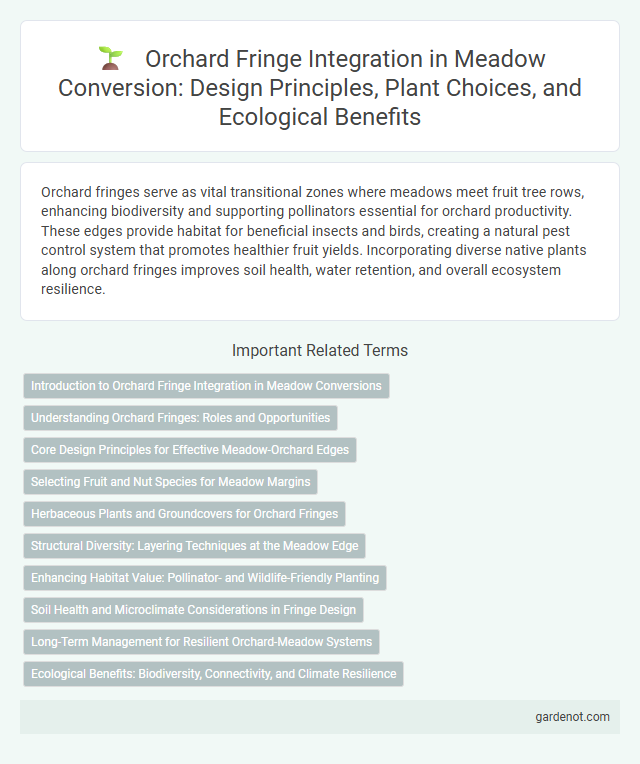Orchard fringes serve as vital transitional zones where meadows meet fruit tree rows, enhancing biodiversity and supporting pollinators essential for orchard productivity. These edges provide habitat for beneficial insects and birds, creating a natural pest control system that promotes healthier fruit yields. Incorporating diverse native plants along orchard fringes improves soil health, water retention, and overall ecosystem resilience.
Introduction to Orchard Fringe Integration in Meadow Conversions
Orchard fringe integration in meadow conversions enhances biodiversity by creating transitional habitats between woodlands and open grasslands. This ecotone supports pollinators, birds, and small mammals, improving ecosystem resilience and connectivity. Managing orchard fringe through selective planting and native species encourages natural regeneration and sustains local wildlife populations.
Understanding Orchard Fringes: Roles and Opportunities
Orchard fringes serve as vital transitional zones that support biodiversity by providing habitat connectivity between orchards and surrounding ecosystems. These margins enhance pollination and pest control through increased insect activity, directly impacting orchard productivity. Managing orchard fringes with native vegetation promotes sustainable agricultural practices and creates opportunities for ecological stewardship.
Core Design Principles for Effective Meadow-Orchard Edges
Orchard fringe design prioritizes biodiversity by integrating native grass species and wildflowers that support pollinators and beneficial insects. Structural layering and gradual plant height transitions create a seamless habitat continuum, enhancing both ecological resilience and orchard productivity. Maintaining soil health through organic matter enrichment and minimal disturbance further strengthens the meadow-orchard edge ecosystem.
Selecting Fruit and Nut Species for Meadow Margins
Selecting fruit and nut species for orchard fringes enhances biodiversity and supports beneficial pollinators essential for meadow conversion. Species like hazelnut, crabapple, and elderberry thrive in meadow margins, providing habitat while offering edible yields. Incorporating native and resilient cultivars ensures sustainable growth and ecological balance in orchard-meadow interfaces.
Herbaceous Plants and Groundcovers for Orchard Fringes
Herbaceous plants and groundcovers play a vital role in orchard fringes by enhancing biodiversity and soil health while suppressing weeds. Species such as wild strawberry (Fragaria vesca), creeping thyme (Thymus serpyllum), and yarrow (Achillea millefolium) create dense, low-growing mats that conserve moisture and provide habitats for beneficial insects. Integrating these plantings in orchard fringes supports pollination, improves nutrient cycling, and reduces soil erosion in meadow conversion projects.
Structural Diversity: Layering Techniques at the Meadow Edge
Orchard fringes enhance meadow biodiversity through structural diversity by employing layering techniques that create multiple vegetative strata. Combining low-growing grasses, mid-height shrubs, and taller trees at the meadow edge fosters microhabitats for various pollinators, birds, and small mammals. This vertical complexity supports ecological functions such as nutrient cycling, pest control, and habitat connectivity in meadow ecosystems.
Enhancing Habitat Value: Pollinator- and Wildlife-Friendly Planting
Orchard fringe planting strategically incorporates native wildflowers and grasses to enhance pollinator activity and provide critical habitat for wildlife, supporting biodiversity in meadow conversions. Selecting species like wild chamomile, oxeye daisy, and field scabious attracts bees, butterflies, and other beneficial insects, increasing ecological resilience. This targeted approach improves ecosystem services, including pollination efficiency and natural pest control, contributing to sustainable orchard management.
Soil Health and Microclimate Considerations in Fringe Design
Orchard fringe design significantly impacts soil health by promoting biodiversity and enhancing nutrient cycling through diverse plant root systems that improve soil structure and organic matter content. Strategic planting in orchard fringes modifies the microclimate by providing shade, reducing wind speed, and maintaining soil moisture, which fosters a more stable and conducive environment for both trees and understorey vegetation. Integrating native grasses and legumes in the fringe area supports beneficial microbial activity, contributing to improved soil fertility and resilience against erosion.
Long-Term Management for Resilient Orchard-Meadow Systems
Orchard fringes serve as critical buffer zones fostering biodiversity and enhancing ecosystem services in meadow conversions. Long-term management practices emphasize maintaining native perennial grasses and wildflowers to support pollinators and natural pest control. Integrating organic mulching and periodic mowing promotes soil health and resilience, ensuring sustainable orchard-meadow landscapes.
Ecological Benefits: Biodiversity, Connectivity, and Climate Resilience
Orchard fringes serve as vital ecological corridors, enhancing biodiversity by providing habitats for pollinators, birds, and beneficial insects critical for orchard health. These buffer zones increase landscape connectivity, facilitating species movement and genetic exchange across fragmented habitats. Their vegetative structure also contributes to climate resilience by improving soil stability, carbon sequestration, and microclimate regulation around orchard ecosystems.
Orchard fringe Infographic

 gardenot.com
gardenot.com